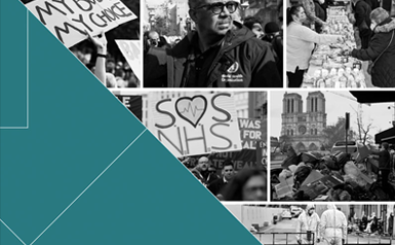Every year, the world’s leading marketers, PR professionals, creatives and advertisers come together for the Cannes Lions International Festival of Creativity, where they showcase (and honor) their best work. Set alongside the harbor and main beach of Cannes, France, they network with their peers and discuss the latest industry trends. One specialist category is Lions Health, focusing on healthcare communications and marketing for the pharma and health & wellness sectors.
It’s a wrap: two days of intense learning and networking at the Lions Health are over, and the winners of the Cannes Lions for Pharma and Health & Wellness have been announced. While the judging, networking and presentations at the Cannes Lions continue, we give you our first take on the cutting edge of healthcare communications marketing.
As one of the Cannes Lions organizers put it: not that long ago, marketing for the Health industry was seen as the “red-headed step child of creativity”. Not anymore. “Creativity that saves lives” is now a force to be reckoned with, and its craft is on par with, and often outshining, that of other industries.
For marketers and communications professionals, it’s an event not to be missed, so whether you made it or not, here is our take on the key trends and some of the award-winning work at this year’s Lions Health in Cannes.
KEY TRENDS
Transformation is the watchword in our industry. At a time of fake news and collapsing trust, consumers’ expectations are changing rapidly and dramatically. Healthcare companies are recognizing that these days it’s simply not good enough to tell consumers “science says so”. Anything labelled “organic” or “natural” is perceived by many as having an edge on products and medication grounded in science. “We were bombarded with negative information about our ingredients… and it didn’t matter that science was on our side,” recalled Alison Lewis, Chief Marketing Officer at Johnson & Johnson Consumer.
To counteract, brands must explore how they can reconnect with consumers without losing their integrity. It was no coincidence that three big companies – GSK, Johnson & Johnson and Merck – all used the Cannes Lions to explain how they are transforming their brand marketing and positioning. Their aims are deeper, more emotional relationships with consumers and better business outcomes. As J&J put it: the transformation was a “reinvention in an age of skepticism.”
Carlton Lawson, Head of Global Categories at GSK Consumer Healthcare, described it as a consumer mindset shift from “I know you” to “I like you” and – most importantly – to “you know me,” where brands show consumers that they truly understand their concerns, and are willing to address them.
For Atilla Cansun, CMO at Merck Consumer Health, it was about making “healthcare irresistible” by sharing people’s aspirations, communicating with emotion and creating “seductive products” that stand out to deliver “love at first sight”.
Empathy with the lives and circumstances of consumers was a theme that dominated discussions in Cannes. Yes, campaigns remain anchored in the efficacy of products and services, but there was a new focus not just on their emotional impact, but also on bringing this empathy to life – through experiential, technological and digital storytelling.
Gaining Trust is the key objective of these campaigns, and it’s more important than ever. As the Edelman Trust Barometer shows, trust in the pharma industry is reaching new lows – suffering a 13-point drop to 38% in the U.S., for example. As brands rebuild their relationships with consumers, they aim to achieve (or deliver) “value”, “love” and “trust”, although ultimately they all mean the same thing: demonstrating to consumers that they understand and address their wants, needs, emotions and concerns. Seeing the case studies on display at Cannes and listening to two days of talks, panels and workshops, with many sessions running in parallel, the “how-to” was obvious: Underpinned by data insights, brands are now focusing on “telling real stories using real people” that use empathy to gain trust (or love). This approach is not without pitfalls. “Everybody tries to be authentic,” but most consumers can see right through when it isn’t, warned an industry outsider on one of the panels.
That’s also why campaigns should not just be about triggering emotions – even though many videos in Cannes were real tear-jerkers. Don’t “lob one-off things over the wall,” health marketers were warned; address real needs and make sure campaigns are scalable.
Transparency, the comms professionals in Cannes agreed, has now definitely become table stakes, even if that means – in the words of J&J’s Alison Lewis – that “in an age of transparency you can’t have any trade secrets”. Consumers not only want transparency, they also demand deep but easy-to-understand information. Brands, though, face the dilemma that while some people are keen to be informed, others refused to engage with public health campaigns for “fear of finding out” (FOFO), as an AbbVie campaign put it, bad news about their health.
THE BUZZ
It’s not just the name: The Cannes Lions at times resemble a crowded zoo. Spare a thought for the jurors, who find themselves trapped every day for 12 hours or more in windowless rooms. Everybody else – and the list of attendees is a rollcall of many of the top names in the industry –is crowding the corridors and event spaces of the “Palais” conference center – to debate, learn and network. If you want to get a feel for where our industry is at, Cannes is the place to be.
The leaders of the digital attention economy – Facebook, Google, Twitter, Pinterest, Spotify, Snapchat and many others – are betting big on offline experiences, occupying a large stretch of the Cannes beach, where they entertain guests at parties fueled by DJs, live acts and plenty of food and drink.
WINNERS
The Pharma and Health & Wellness categories saw plenty of change this year; they now have a clear distinction between regulated and unregulated campaigns, as well as a separate category for non-profit work.
Here are links to the full lists of winners in Health and Wellness and Pharma.
What became obvious is that there is no difference in terms of creativity and craft between campaigns for regulated and unregulated products and services. For the best campaigns, purpose and brand values were inextricably linked, with campaigns often delivering life-changing outcomes.
There was enormous diversity in the campaigns, but there were a few trends: many campaigns focused on helping children understand or cope with their illnesses, like “Zac’s play day”, a children’s book helping youngsters living with spinal muscular atrophy (SMA), and – a double gold winner – “The Imaginary Friends Society”, which uses cartoons and a (yet to be launched) AR experience to help children with cancer.
Gender equality and female health issues were other big story strands, like the much-lauded Stay-free campaign that helped sex workers in India to learn skills on their “days off”, which are the three days when they have their period.
Effectiveness and measurable results reign. An Eli Lilly campaign featured the “smallest booth” ever made, raising awareness for STS – an extremely rare cancer – and targeting 144 specialists, with the campaign reaching more than 70% of them. “TV Doctors of America, Season 2”, from Cigna won, demonstrating the value of humor and the importance of delivering measurable outcomes, in this case boosting the number of doctor visits.
It’s worth noting that the shortlisted work and the winners came from all around the world, with some of the most creative ideas hailing from smaller markets.
INSIDE THE JURY ROOM
So what makes a winner? It obviously starts with a great creative idea, but two sessions gave marketers a glimpse inside the jury rooms for Pharma and Wellness & Health. Here are some of the tips and warnings of this year’s jurors.
Health & Wellness
The Grand Prix went to “Corazon – Give Your Heart”, a campaign to drive organ donations for Montefiore hospital, with another eight gold lions awarded in this category. From the jurors:
- Integrated campaigns with broad reach that triggered change and had measurable outcomes came out on top.
- Winning campaigns “elevate the industry”, they drive creativity, raise the profile of our industry and change how we communicate and interact.
- It’s the idea that matters – and a powerful case-study film helps too.
- The idea has to be authentic. It has to scale. It has to solve a problem.
- Film is gaining in prominence (in contrast to print and photography), as is technology.
Pharma
The Pharma category did not award a Grand-Prix for the second year running; jury president Rich Levy said that “there was no campaign that lived up to the idea of genuinely life changing-creativity”.
There were only two Gold Lions, awarded to “Blink to Speak” (a campaign for the Asha Ek Hope Foundation in India, teaching patients with ALS a ‘blink language’) and “Change Gout “(for Grunenthal, who wanted to help healthcare professionals gain a better understanding of the illness). The jurors said:
- We want campaigns that “show us what the future of communication and marketing look like”.
- It’s not enough to “raise awareness”. Action and outcomes are critical.
- We have seen enough suffering in slow-motion and black & white. Give humor a chance.
- Be mindful where you enter your work. A scattergun approach doesn’t work.
TAKEAWAYS
- Trust is essential to build relationships with patients and caregivers, which makes them essential for brand success.
- Campaigns must be grounded in empathy and emotional storytelling.
- Measuring outcomes has to be an integral part of your campaign.
- Brands are expected to do more. Go beyond the science, treatment outcomes and product benefits. Demonstrate value to the individual that changes society or their lives.
- Focus on communication. Even emotional campaigns have to have a message at their heart.
- Brand transformation is not a journey from A to B, but a never-ending story.
- Technology is gaining ground – either for campaign delivery, or as a tactic that sits at the heart of a campaign.
- Integrated campaigns that take an idea and play it out across the whole spectrum of communications marketing have the best chances of winning big in Cannes.



